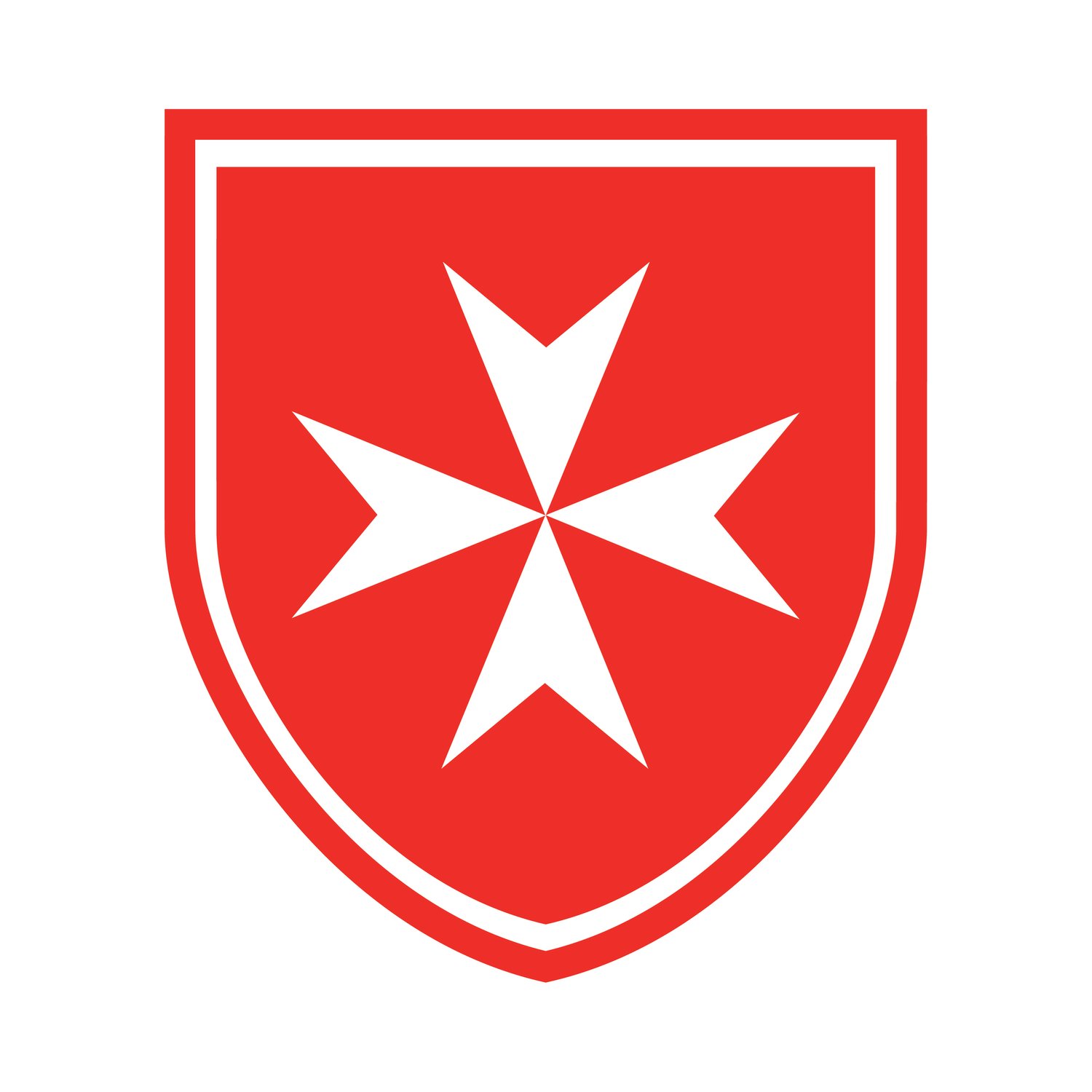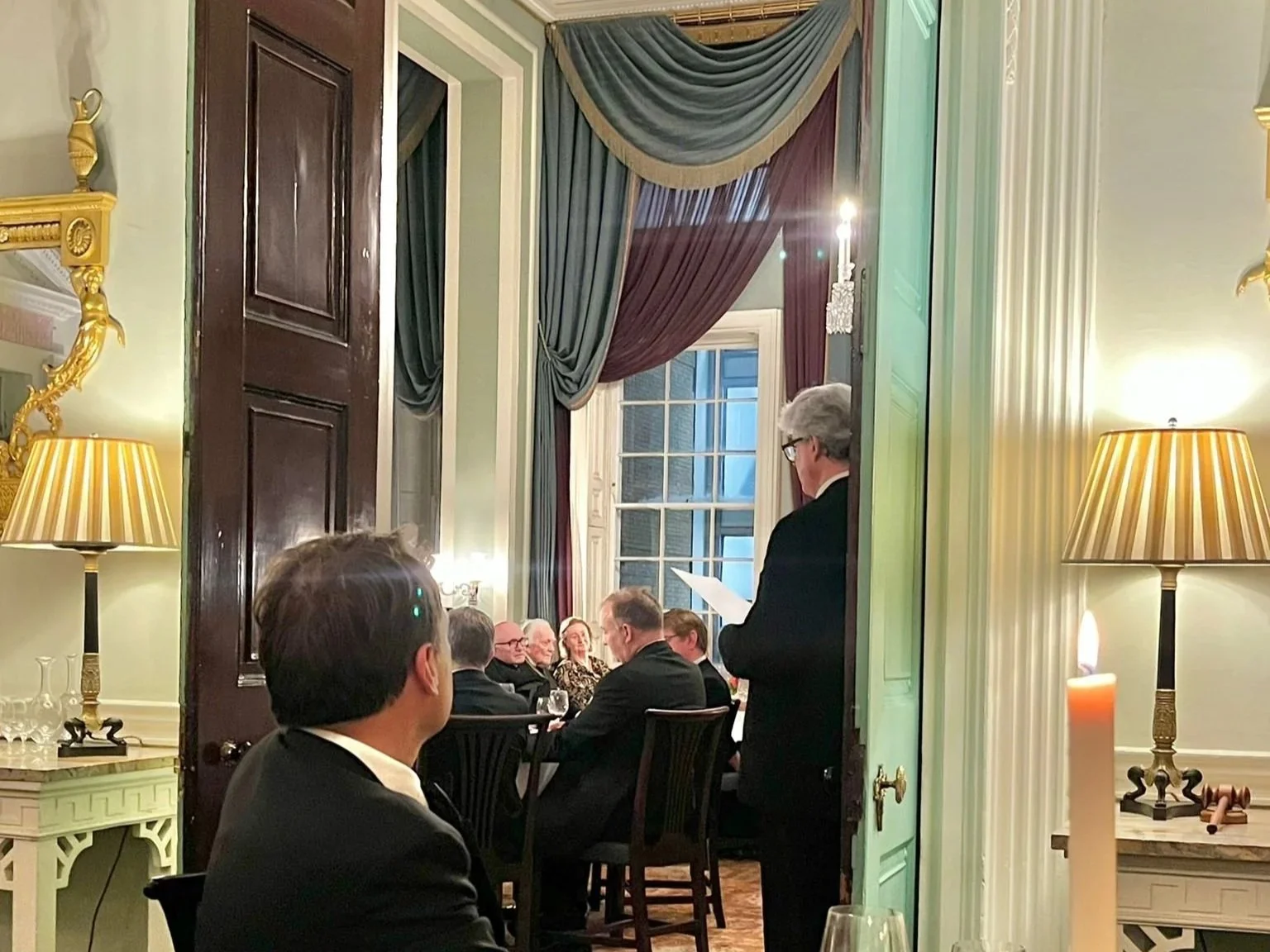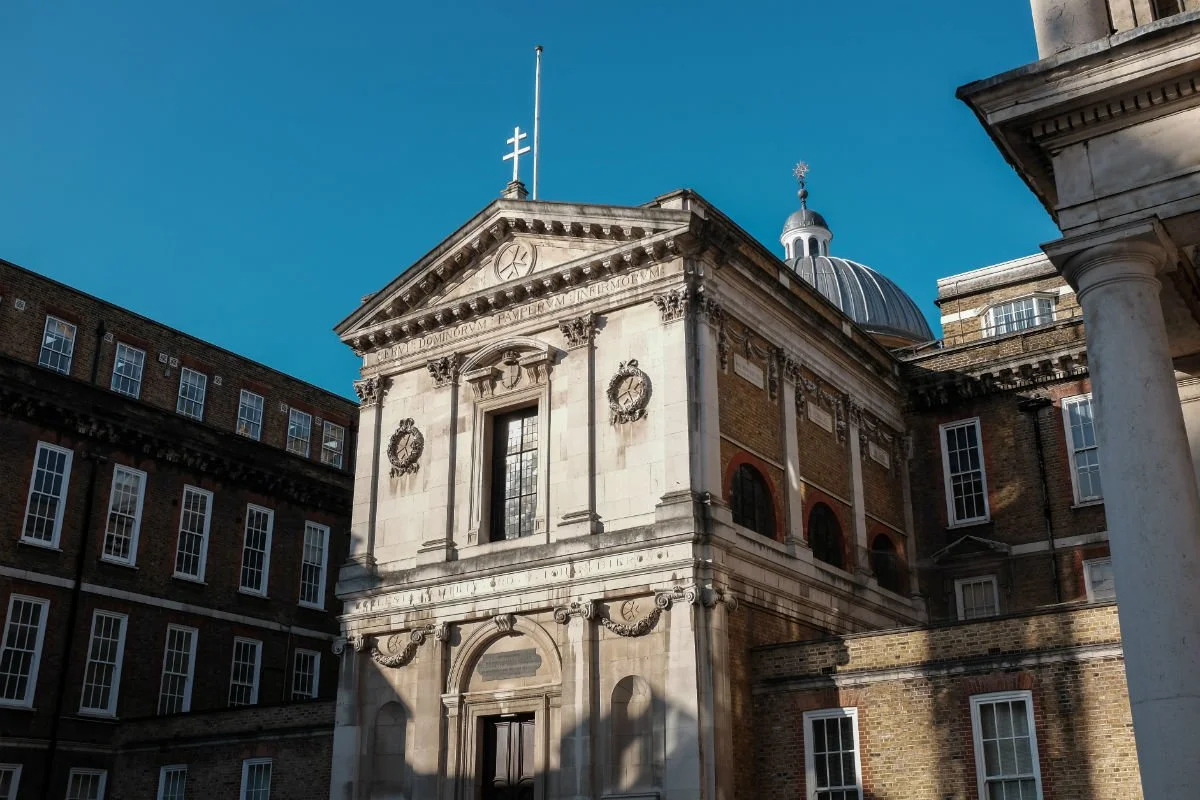Annual Dinner
On Friday 3 October, the President of the British Association, Lady Celestria Hales, hosted a dinner for members of the Order in Britain. The dinner marked the beginning of the celebrations of the British Association’s 150th anniversary year. The President was joined by the Grand Prior of England, Fra’ Max Rumney, and one hundred and twenty others, members and guests, at Boodles. After dinner, Anthony Delarue, Knight of Magistral Grace in Obedience, gave a wonderful survey of the history of the Order in these lands and exhortation for the future, the text of which we are pleased to be able to reproduce below:
My Lady, dear President; Excellencies; Ladies and Gentlemen, I am deeply honoured to have been asked to speak for this anniversary dinner, if not still a little bemused, as I know some of my friends here are too!
The President is not the first of the name of Hales to lead the Order in Britain. A namesake, Sir Robert Hales, (whom she wisely declines to firmly count as a kinsman) was elected Prior in 1372. He was Treasurer of England, and it was he who was charged to introduce the Poll Tax (your only connexion, President, I think with Margaret Thatcher!) he was then beheaded by the mob on Tower Hill in the Peasant’s Revolt, together with the archbishop of Canterbury. Their heads were stuck up on London Bridge. The mob also destroyed our priory church and buildings at Clerkenwell. England is, perhaps, now a little more civilised, and however it may sometimes feel, dear President, your life is calmer!
The President, Lady Celestria Hales, Peregrine Bertie, Mgr John Armitage, and others listen to Anthony Delarue speaking.
It might be thought that a talk opening a 150th anniversary year would begin with a date 150 years ago. But no! We are not celebrating the foundation of an institution, but a restoration, a renewal. Our story begins nearly a millennium ago when the Order of Saint John first came to these shores. The Priory of England was one of the first to be established in the new Order, and the Brethren were active here certainly by 1102, more that ten years before Pope Paschal II’s bull, Pie Postulatio Voluntatis, for which many of us went to Rome for the 9th centenary in 2013, and which gave us formal recognition and established the structure and independence of the Order which still continues to guide its Constitution today. In 1130 the Knights were given the lands at Clerkenwell and there established their headquarters, so, another great anniversary is coming up in five years time, the 900th of the establishment of the British Priory, to which we all are heirs! Some ten or twenty years later King David of Scotland gave the village of Torphichen as the Order’s Scottish headquarters. Both of these were lost at the Reformation.
So many people today, even good Catholics, under the influence of years of Protestant false history, still see the Faith as somehow not entirely English, brought in lately, the religion of foreigners – the recusant families being a rare and noble exception. But mediaeval England was a very Catholic land, and very loyal to Rome, and the Order’s properties here were extensive. We played a full part in the military and hospitaller life of Jerusalem and Rhodes, the Langue of England and its captain the Turcopolier, being responsible for coastal defences. Priors of the Order sat in the Lords by right, and held great offices of state in England through many reigns; and in the years immediately before the Reformation there were around 45 commanderies with some 2,000 properties, and the Priory’s monetary returns to Rhodes in responsions, a ⅓ of its income, which paid for the Mediterranean works of the Order, were, at their height in the 14th century, some £2,300 annually, the equivalent of £1.8 million today!
All this was brutally destroyed by King Henry VIII, giving the Order several more martyrs, whose memory we are happy to keep. Yet in the centuries which followed, men from these islands continued to join the Order and to serve the cause of the Church, and of the Christian states in the Mediterranean, ever faithful to the aims of our Rule and charism.
Such was the world to which the 19th century Knights of Malta in Britain looked back, not with nostalgia, but, in the spirit of Cardinals Newman, Wiseman and Manning, who were rebuilding the Church here, with a desire to reconstruct the life of service and Catholic care of the Sick, which has run through the veins of the knight of Saint John since the days of blessed Gerard. In the early 1850’s a handful of young men put their enthusiasm into action, and one, Sir George Bowyer, baronet, who can rightly be regarded as our founder, with Cardinal Wiseman, and with the social and political influence of the Duke of Norfolk and of Lord Petre, established and built a hospital in Great Ormond Street, which was later to develop into the great Children’s Hospital we know today. So we see, that approached in the correct spirit, the Order’s work, from the days of Blessed Gerard, and again in our own, starts with hospitaller work, and the formal structures follow on.
Bowyer had also wanted to restore the nuns of the Order to nurse the Hospital, but since the Napoleonic depredations, the Order had no structure for the formation of female religious, and so, building a convent next to the church, in 1856 he and Cardinal Wiseman invited the newly-founded Sisters of Mercy from Bermondsey, who had expanded greatly while nursing in the Crimea under Florence Nightingale, to staff their new Hospital; Bowyer successfully petitioned the Lieutenant Grand Master to grant them the right to the Order’s Cross on their habit; and I remember seeing them still in St John and St Elizabeth’s as a child in the 1970’s. As a measure of the esteem in which the Sisters were held, Cardinal Wiseman had given them Mary Queen of Scots’s rosary.
The first Saint John’s Day Mass for our Knights since the Reformation had been celebrated by Fr Edward Stonor in 1860, in the temporary hospital chapel. But we are a religious Order, and a religious Order needs a church, so attached to the Hospital, Bowyer built, entirely at his own expense, a fine classical building, which since its opening was used by the Knights in England - Fr Stonor and Fr Charles Petre Eyre, later archbishop of Glasgow, ensured the regular Masses in the new church, opened in 1864. It is dedicated, as many of our churches worldwide, to Saint John of Jerusalem.
The exterior of the Order’s conventual church at the Hospital of Ss John and Elizabeth, St John’s Wood.
In parallel with this, Bowyer, and other knights, had initially been pursuing the projected restoration of a so-called Langue of England at Clerkenwell with the Anglicans; the failure of this rather eccentric oecumenical project which clearly could never have worked, and which was later to become the Venerable Order, can truly be seen as Divine Providence. As time progressed they petitioned the Grand Magistry in Rome for the restoration of the Catholic Priory, and Bowyer, a romantic figure, saw himself as the new Prior. But, as so often happens in such negotiations, the discussions were fraught with disagreement and quarrelling, sometimes very colourful, and a decision was made in Rome to begin cautiously by erecting a formal Association of knights, the first such in the world. So though numerically the British have always been small in the wider Order, it can be seen that throughout history we are often in the vanguard.
Sovereign Council approved the statutes in December 1875, and on the Feast of Our Lady Help of Christians, May 1876, the Association was formally established at the first Assembly, held in the Order’s church, after Holy Mass celebrated by the chaplain of the Hospital.
The President, Lord Granard, announced that some 40 members in Britain had joined the Association, including three Dames, and many of the families who continue in the Order today; among them also nine professed Knights in simple vows. Inevitably there were a few grumblers who refused! At the Assembly, he outlined the new statutes sent from Rome, and, as the minutes record, underlined the importance of strict adherence and loyalty to them. We are after all a religious and military Order!
By the 1890’s the Hospital site had grown too small, and land was acquired in St John’s Wood, site of a pre-Reformation commandery, hence its name, and a new hospital was built, to provide maternity care and later serve war-wounded. Our lovely church was dismantled stone by stone and rebuilt identically at the centre of the new hospital, a tribute to the place it held in the Order’s heart, already some fifteen years after Bowyer’s death. It served the Order for well over a century more, until further quarrels intervened, as they always do in the Order’s projects, a most comforting proof that the Devil hates us, and all our works!
The Hospital continued as the primary work of the Order in Britain for much of the 20th century, caring for the wounded of both World Wars. For many years the nursing school was among the finest in the land; the graduate nurses wearing a distinctive silver belt-buckle bearing our Cross. Under the National Health Acts it became increasingly difficult to operate a Catholic hospital on this charitable model, donations could not keep up with increased costs, and so gradually, ward by ward, it became a private fee-paying hospital, wholly so by the end of the century. But in 1984 it was extended with a Hospice for the care of the dying, founded by Fra’ Andrew Bertie, along with Peter Drummond-Murray, under the chairmanship of Lord Gainsborough, the President’s father.
In 1953 a small group of young knights and dames had gone to Lourdes for the first time, joining their German brethren, who took lots of Malades by train, to increase both their hospitaller and spiritual commitment, and this grew rapidly into the big pilgrimage we know today. It was in Lourdes that year that the new choir-dress was first worn, another British success which spread to the whole Order within a year, the creation of Lord Harvington, as Director of Ceremonies. The choir-dress’s world debut had in fact been at the High Mass celebrated by Cardinal Griffin on the night before the Coronation of Queen Elizabeth!
The Venerable Servant of God Fra’ Andrew Bertie, later Prince and Grand Master, processing into the conventual church to make his solemn vows, the first English knight to do so since the Reformation.
In the late 1970’s various members, led by Michael Rapinet (who is happily still with us) and Lord Gainsborough, got together to found the Order of Malta Homes Trust, starting with the now well-known house in Arundel. Initially it was very much a work of the Order, and was truly ground-breaking at that date. Many years after, as the charity grew, we were joined by the Venerable Order, which assisted fund-raising, allowing more homes to be acquired, and it became the Orders of St John Care Trust.
Fra’ Andrew had also founded the OMV with Gilbert, Lord Monckton of Brenchley, and later Nigel Stourton, to assist the members in hospitaller work and to provide a spiritual formation for the young within the Order family, and act as a youthful recruiting ground for vocations to the Order, which continues very active today.
After the Second World War the number of professed members grew, and on St John’s Day in 1970 a sub-Priory was set up for them, and for the newly-formed grade of knights in Obedience, established to assist in the governance of the Order and provide a deeper spiritual attachment, as it continues to do. As the Council minutes record, the President’s father, Bailiff the Earl of Gainsborough, then himself President of the Association, was the sub-Priory’s first Hospitaller. Bailiff Lord Robert Crichton-Stuart, Fra’ Freddy’s uncle, was Regent; his banner is laid up in the Church in St John’s Wood.
But for many years Fra’ Andrew Bertie and other young members had dreamt of completing the original project of restoring the Priory, which had been approved in principle by Sovereign Council already in the late 1940s, but these things take time. As Grand Master he was finally able to achieve this in 1993, with the collaboration of the Regent of the sub-Priory, his friend Anthony, Lord Furness. Sadly Lord Furness was too ill to take up the role of 55th Grand Prior, and as we know this privilege went to Fra’ Matthew Festing, who was later to succeed Andrew Bertie as 79th Grand Master.
Today, as throughout our 900 year history, the Order in Britain responds to the needs of the world, and is increasingly involved in international humanitarian aid and care for the homeless in our cities. The Scottish Companions, set up in Edinburgh by Fra’ Freddy Crichton-Stuart in the late 1990’s, were extended to the whole of Britain in 2010, and have provided a wonderful army of foot-soldiers, many present tonight, to assist in the Order’s apostolate, greatly expanding our work around the country.
This room is full, and full of young people, and we can look forward with confidence to another 150 years’ service of the Order of Malta in Britain, in whatever form the changing world of the future may need. Who knows what this future will hold? The Order changes, and changes often, to respond to the world of the day. But this we know – always staying true to our tradition and charism. Along with Faith and Charity this demands Tenacity, one of the four cardinal virtues. There are many pressures from without, and from within, for the Order to change — many people in this room have experience of this in varying ways. There will always be those who think they know better, who wish to remake the Order to reflect the latest ideas and fashions. That is not the way of our predecessors, or we should not be here — just keep going, stick to your guns, and pray; and you will achieve, as with those saintly knights and dames who have gone before, great things, always faithful to our Tradition.
Ad Multos Annos !



